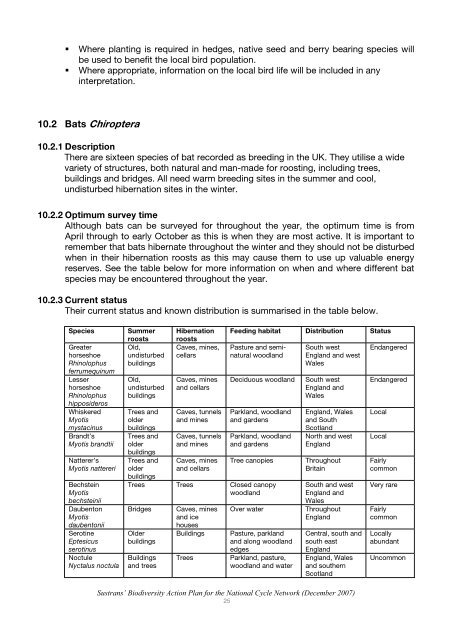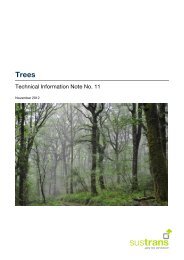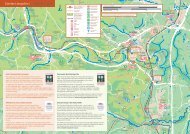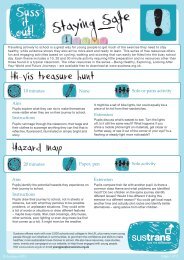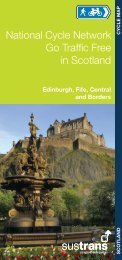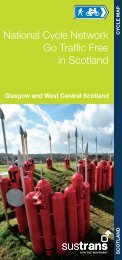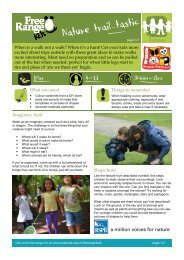Biodiversity Action Plan for the National Cycle Network ... - Sustrans
Biodiversity Action Plan for the National Cycle Network ... - Sustrans
Biodiversity Action Plan for the National Cycle Network ... - Sustrans
You also want an ePaper? Increase the reach of your titles
YUMPU automatically turns print PDFs into web optimized ePapers that Google loves.
Where planting is required in hedges, native seed and berry bearing species will<br />
be used to benefit <strong>the</strong> local bird population.<br />
Where appropriate, in<strong>for</strong>mation on <strong>the</strong> local bird life will be included in any<br />
interpretation.<br />
10.2 Bats Chiroptera<br />
10.2.1 Description<br />
There are sixteen species of bat recorded as breeding in <strong>the</strong> UK. They utilise a wide<br />
variety of structures, both natural and man-made <strong>for</strong> roosting, including trees,<br />
buildings and bridges. All need warm breeding sites in <strong>the</strong> summer and cool,<br />
undisturbed hibernation sites in <strong>the</strong> winter.<br />
10.2.2 Optimum survey time<br />
Although bats can be surveyed <strong>for</strong> throughout <strong>the</strong> year, <strong>the</strong> optimum time is from<br />
April through to early October as this is when <strong>the</strong>y are most active. It is important to<br />
remember that bats hibernate throughout <strong>the</strong> winter and <strong>the</strong>y should not be disturbed<br />
when in <strong>the</strong>ir hibernation roosts as this may cause <strong>the</strong>m to use up valuable energy<br />
reserves. See <strong>the</strong> table below <strong>for</strong> more in<strong>for</strong>mation on when and where different bat<br />
species may be encountered throughout <strong>the</strong> year.<br />
10.2.3 Current status<br />
Their current status and known distribution is summarised in <strong>the</strong> table below.<br />
Species<br />
Greater<br />
horseshoe<br />
Rhinolophus<br />
ferrumequinum<br />
Lesser<br />
horseshoe<br />
Rhinolophus<br />
hipposideros<br />
Whiskered<br />
Myotis<br />
mystacinus<br />
Brandt’s<br />
Myotis brandtii<br />
Natterer’s<br />
Myotis nattereri<br />
Bechstein<br />
Myotis<br />
bechsteinii<br />
Daubenton<br />
Myotis<br />
daubentonii<br />
Serotine<br />
Eptesicus<br />
serotinus<br />
Noctule<br />
Nyctalus noctula<br />
Summer<br />
roosts<br />
Old,<br />
undisturbed<br />
buildings<br />
Old,<br />
undisturbed<br />
buildings<br />
Trees and<br />
older<br />
buildings<br />
Trees and<br />
older<br />
buildings<br />
Trees and<br />
older<br />
buildings<br />
Hibernation<br />
roosts<br />
Caves, mines,<br />
cellars<br />
Caves, mines<br />
and cellars<br />
Caves, tunnels<br />
and mines<br />
Caves, tunnels<br />
and mines<br />
Caves, mines<br />
and cellars<br />
Feeding habitat Distribution Status<br />
Pasture and seminatural<br />
woodland<br />
Deciduous woodland<br />
Parkland, woodland<br />
and gardens<br />
Parkland, woodland<br />
and gardens<br />
Tree canopies<br />
Trees Trees Closed canopy<br />
woodland<br />
Bridges<br />
Older<br />
buildings<br />
Buildings<br />
and trees<br />
Caves, mines<br />
and ice<br />
houses<br />
Buildings<br />
Trees<br />
Over water<br />
Pasture, parkland<br />
and along woodland<br />
edges<br />
Parkland, pasture,<br />
woodland and water<br />
South west<br />
England and west<br />
Wales<br />
South west<br />
England and<br />
Wales<br />
England, Wales<br />
and South<br />
Scotland<br />
North and west<br />
England<br />
Throughout<br />
Britain<br />
South and west<br />
England and<br />
Wales<br />
Throughout<br />
England<br />
Central, south and<br />
south east<br />
England<br />
England, Wales<br />
and sou<strong>the</strong>rn<br />
Scotland<br />
Endangered<br />
Endangered<br />
Local<br />
Local<br />
Fairly<br />
common<br />
Very rare<br />
Fairly<br />
common<br />
Locally<br />
abundant<br />
Uncommon<br />
<strong>Sustrans</strong>’ <strong>Biodiversity</strong> <strong>Action</strong> <strong>Plan</strong> <strong>for</strong> <strong>the</strong> <strong>National</strong> <strong>Cycle</strong> <strong>Network</strong> (December 2007)<br />
25


